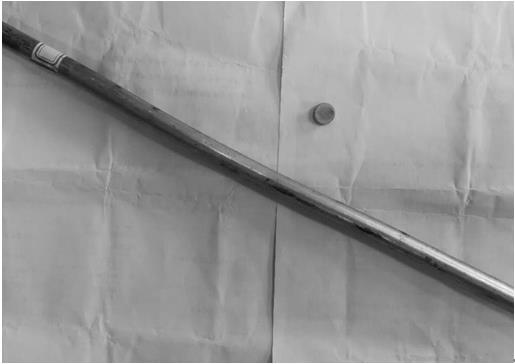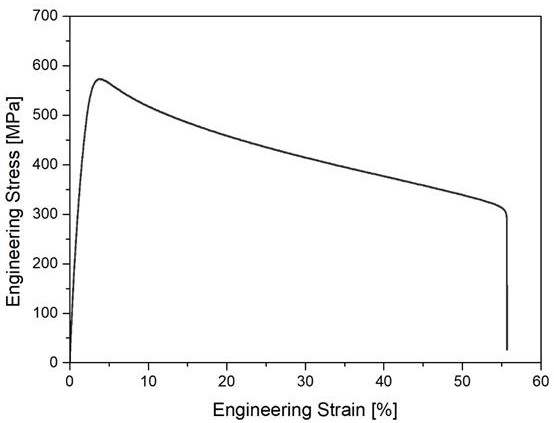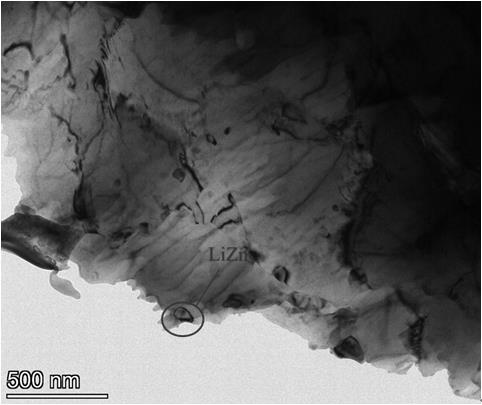Biodegradable ultra-fine grain Zn-Li alloy material as well as preparation method and application thereof
An alloy material and ultra-fine grain technology, applied in the field of biodegradable metal materials, can solve the problems of poor comprehensive mechanical properties of pure zinc, unsatisfactory strength and ductility, etc., to improve comprehensive mechanical properties, controllable degradation rate, avoid The effect of secondary surgery
- Summary
- Abstract
- Description
- Claims
- Application Information
AI Technical Summary
Problems solved by technology
Method used
Image
Examples
Embodiment 1
[0029] Preparation and property testing of Zn-0.5Li alloy. The mass fraction of Li in the Zn-0.5Li alloy is 0.5%, and the balance is Zn. The alloy preparation process is smelting→casting→hot extrusion→multi-pass drawing at room temperature. The specific method is: weighing the corresponding ratio of pure zinc and Zn-Li master alloy into a crucible, and melting in an induction melting furnace. Heat the Zn-Li master alloy and 90% pure zinc to 600°C, keep it warm for about 5 minutes, and stir evenly. After it is completely melted, add the remaining 10% pure zinc, and stir to remove the slag after it is completely melted. Pour the above-mentioned cast zinc alloy into a cylindrical casting mold preheated at 500°C, and air-cool to room temperature (25°C). Put the cylindrical cast zinc alloy taken out from the mold and the extrusion mold into a box furnace and heat to 260° C., keep it warm for 2 hours, and extrude it to a bar with a hydraulic press, with an extrusion ratio of 20. ...
Embodiment 2
[0031] Preparation and performance test of Zn-0.05Li alloy. The mass fraction of Li in the Zn-0.05Li alloy is 0.05%, and the balance is Zn. The alloy preparation process is smelting→casting→hot extrusion→multi-pass rotary forging at room temperature. The specific method is: weighing the corresponding ratio of pure zinc and Zn-Li master alloy into a crucible, and melting in an induction melting furnace. Heat the Zn-Li master alloy and 90% pure zinc to 550°C, keep it warm for about 5 minutes, and stir evenly. After it is completely melted, add the remaining 10% pure zinc, and stir to remove the slag after it is completely melted. Pour the above-mentioned cast zinc alloy into a cylindrical casting mold preheated at 520°C, and air-cool to room temperature (25°C). Put the cylindrical cast zinc alloy taken out from the mold and the extrusion mold into a box furnace and heat to 250° C., keep it warm for 2 hours, and extrude it to a rod with a hydraulic press, and the extrusion rati...
Embodiment 3
[0033]Preparation and performance test of Zn-1Li alloy. The mass fraction of Li in the Zn-1Li alloy is 1%, and the balance is Zn. The alloy preparation process is smelting→casting→hot extrusion→multi-pass rotary forging at room temperature. The specific method is: weighing the corresponding ratio of pure zinc and Zn-Li master alloy into a crucible, and melting in an induction melting furnace. Heat the Zn-Li master alloy and 90% pure zinc to 580°C, keep it warm for about 5 minutes, and stir evenly. After it is completely melted, add the remaining 10% pure zinc, and stir to remove the slag after it is completely melted. Pour the above-mentioned cast zinc alloy into a cylindrical casting mold preheated at 550°C, and air-cool to room temperature (25°C). The cylindrical cast zinc alloy taken out of the mold and the extrusion mold are put into a box furnace and heated to 300° C., kept for 2 hours, and extruded to a rod by a hydraulic press with an extrusion ratio of 20. Then carr...
PUM
| Property | Measurement | Unit |
|---|---|---|
| Tensile strength | aaaaa | aaaaa |
| Yield strength | aaaaa | aaaaa |
| Average grain size | aaaaa | aaaaa |
Abstract
Description
Claims
Application Information
 Login to View More
Login to View More - R&D
- Intellectual Property
- Life Sciences
- Materials
- Tech Scout
- Unparalleled Data Quality
- Higher Quality Content
- 60% Fewer Hallucinations
Browse by: Latest US Patents, China's latest patents, Technical Efficacy Thesaurus, Application Domain, Technology Topic, Popular Technical Reports.
© 2025 PatSnap. All rights reserved.Legal|Privacy policy|Modern Slavery Act Transparency Statement|Sitemap|About US| Contact US: help@patsnap.com



